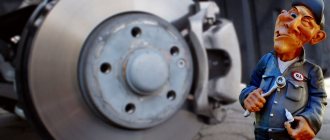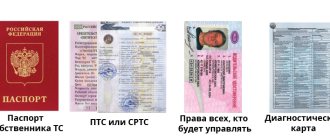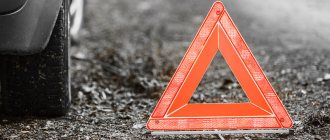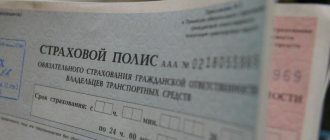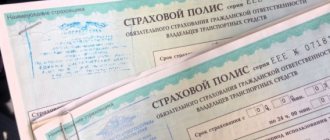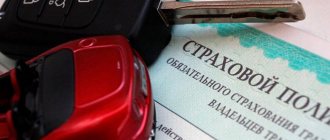What is a diagnostic card
A diagnostic card is a document that confirms that the car is in proper technical condition.
Due to changes in automobile legislation in 2011, it became a replacement for the vehicle inspection ticket. They look very different. The inspection ticket looked like a green card, on both sides of which the relevant information about all the necessary degrees of protection was applied: a hologram, a unique number, hidden markings, a special microstructure.
The map is an A4 sheet. It includes information about the technical condition of the car. The document contains 65 information blocks that contain data on those machine systems that ensure its safe operation. That is, this document confirms that the car can be driven safely.
The card does not have an approved appearance - it depends on the organization that issued it. The legislation regulates only the presence of the indicated 65 blocks.
Do you need a diagnostic card for compulsory motor liability insurance in 2021?
Dear readers!
Our articles talk about typical ways to resolve legal issues, but each case is unique. If you want to find out how to solve your particular problem, please contact the online consultant form
It's fast and free!
Or call us by phone (24/7):
If you want to find out how to solve your particular problem, call us by phone. It's fast and free!
+7 (495) 980-97-90(ext.589) Moscow,
Moscow region
+8 (812) 449-45-96(ext.928) St. Petersburg,
Leningrad region
+8 (800) 700-99-56 (ext. 590) Regions
(free call for all regions of Russia)
What else to read:
- My car was scratched in the yard, what should I do?
- Europrotocol 2021
- How to get money instead of repairs under compulsory motor liability insurance: a detailed review
In most cases, it is impossible to obtain a policy without a diagnostic card. If this document is not available, traffic police officers may recognize the MTPL policy as fake. Maps are entered into the EAISTO database. Information about them is stored there for five years.
However, in some situations the card is not needed. This applies to the purchase of a new car and a car less than three years have passed since its release. If the car is older, you cannot do without a diagnostic card.
To determine the age of the car, the owner must provide the insurer with a vehicle passport. In accordance with the law, it is this document, and not the date of actual manufacture of the car, that must be used to calculate the full years of transport.
The diagnostic card is issued in two copies. One is given to the owner of the car, the other remains at the VET. The document must include the signature and seal of the expert who assessed the vehicle. In addition, the card must have a unique 21-digit number. It is he who is entered into the EAISTO database.
Frequency of technical inspection
We have looked at what deadlines for passing a technical inspection for new and old cars (by year) are set for obtaining a diagnostic card. But there are some nuances in this issue that it is better to familiarize yourself with in advance. They relate exclusively to the age limit of the vehicle.
New car
By the phrase “new car”, drivers mean movable property purchased in a showroom, and not from hand. But according to the traffic police regulations, this concept is tied not to the place where the car was purchased, but to its year of manufacture. Thus, it turns out that even when purchasing a vehicle from a dealer, it needs to be checked not once every three years, but every 24, or even 12 months.
And this is a very important point. After all, the MTPL policy, when registering a vehicle through a dealership, is issued to the client on the spot. But when it loses its legal force, motorists do not immediately find out, which becomes a common reason for receiving a fine for expired insurance. Therefore, it is better to study documents for movable property in advance, so as not to encounter unnecessary expenses.
Boo
A similar principle applies to used vehicles. For example, if the car was purchased by the first owner in 2021, and the second owner transferred it to himself just 2 months from the specified date, then for his “iron horse” the maintenance will begin by 2022. But this is provided that the year The release of the vehicle is completely identical to the year of purchase. For old cars, a technical certificate is issued every 12 months, regardless of their condition.
Where to get a diagnostic card
Technical service stations (STO) and technical inspection points (PTO) have the right to issue diagnostic cards and conduct technical inspections of vehicles, respectively. But even among these companies, not all stations and points can conduct technical inspections, but only those that have received accreditation from the RSA and have entered into a special agreement with the Ministry of Internal Affairs.
You can find out whether the item you are interested in is on the list of such companies in the following ways:
- Go to the official website of the Russian Union of Auto Insurers (RUA) and find information there about all technical and service stations that are accredited. You can select any convenient organization, and also print the list.
- Another option is to ask your insurance company about where you can get a diagnostic card. Insurers have lists of all technical and service stations that have accreditation.
Who will remind you about the inspection period?
In accordance with the legislation of the Russian Federation, the owner of the movable property must remember about the expiration of the period of validity of the diagnostic certificate. But in view of the fact that the mentioned document is most often issued for the further registration of an insurance policy, with a similar duration, a call from an agent can serve as a reminder for the driver.
Attention! But, of course, you shouldn’t hope for such a combination of circumstances. Indeed, in case of delay in maintenance, only the owner of the vehicle will be held responsible, and no one else. This means that he himself, and not the employees of the insurance company, is obliged to monitor the frequency of inspection.
Its validity period
The duration of the diagnostic card is determined by the life of the machine, its size and purpose.
- If the car has been used for no more than seven years, you need to undergo a technical inspection and receive a card every two years.
- With a service life of seven years or more, a technical inspection must be carried out once a year.
- Owners of cars intended for transporting passengers (having more than 8 seats) must receive a diagnostic card at least once every six months.
How often should you have your car inspected?
To better understand the rule about the frequency of vehicle inspection, you should understand what this process should look like in practice. Let's say the car was purchased in 2005.
So the frequency will look something like this:
- First inspection - 2008. This is 3 years later.
- The second is 2010. This is from the rule about inspection every two years.
- Third – 2012.
Fourth, next times – 2013, 2014, 2015. That is, annually.
When counting years, you should also take into account the time that the car sat in the dealership. Therefore, if a driver purchased a certain model, say, in 2005, and the year of manufacture is 2003, then the first inspection is carried out within a year.
In addition, the frequency of maintenance varies according to needs: if the engine breaks down, an additional inspection is carried out. The carburetor is not adjusted - the driver either adjusts it himself or takes it to a car repair shop. Such inspections may not be documented, but the goal is achieved: the insides are studied in detail, the breakdown is corrected, and preventive measures are taken to prevent such breakdowns.
How to get a diagnostic card: a guide to action
To pass the inspection and receive a diagnostic card, you need to do the following:
- Select a service station or technical service station where you will undergo a technical inspection. This must be an accredited company. By law, a driver can undergo inspection in any city and region of the country, regardless of where the car was registered.
- Conclude an agreement with the selected company and pay for services.
- For the procedure, you will need to present an identification document of the driver and a vehicle registration certificate.
- It is also necessary to provide the vehicle for diagnostics. It is important that its condition is in good condition, since otherwise it will not be possible to obtain a diagnostic card. If the result of the technical inspection is unsatisfactory, the driver will receive 20 days to eliminate the defects. If this is done, you will be able to get a second inspection from the same company during this time, free of charge. In this case, not a full inspection is carried out - only detected faults are assessed.
Nothing has changed in the inspection procedure itself. The car is driven to a special stand, then specialists inspect its visibility elements, check the serviceability of the brake system, the functioning of the alarm and lighting system, exhaust toxicity, the presence of a first aid kit, a fire extinguisher, and so on.
If you lose your diagnostic card, you need to contact the service station or technical service station where you received it. The service will cost 300 rubles.
Car maintenance is carried out according to the so-called planned preventative system. The peculiarity of this system is that all cars undergo mandatory maintenance according to a schedule. The main purpose of maintenance is to prevent failures and malfunctions, prevent premature wear of parts, and timely elimination of damage that interferes with the normal operation of the vehicle. Therefore, maintenance is a preventative measure.
A failure is a violation of the vehicle’s performance, leading to a temporary cessation of its normal operation (stopping on the line, violation of the traffic schedule, etc.).
All other deviations of the technical condition of the rolling stock and its units from the established standards are malfunctions.
Maintenance includes cleaning and washing, control and diagnostic, fastening, lubrication, refueling, adjustment and other work, performed, as a rule, without disassembling the units and removing individual components from the vehicle.
According to the current regulations, maintenance, based on the frequency, volume and labor intensity of the work performed, is divided into the following types:
daily maintenance (DM);
first maintenance (TO-1);
second maintenance (TO-2);
seasonal maintenance (MS).
Daily maintenance includes cleaning and washing work, as well as general monitoring of the vehicle’s condition, aimed at ensuring traffic safety and maintaining proper appearance.
Carrying out daily maintenance, they perform cleaning and washing work, control inspection, refilling with fuel, coolant and oil. Work on EO is carried out after the vehicle has finished working on the line and before leaving the line.
The first maintenance includes all work performed during daily maintenance. In addition, it includes a number of additional fastening, lubrication and control and adjustment work, carried out without removing units and devices from the vehicle and disassembling them.
The second maintenance, in addition to the set of operations included in TO-1, involves performing inspection, diagnostic and adjustment work of a larger volume with partial disassembly of the units. Individual devices are removed from the vehicle and tested on special stands and control and measuring installations.
Seasonal maintenance is carried out twice a year and involves performing work related to the transition from one season to another, and they try to combine it with the next maintenance-2. Typical work for the CO is: flushing the cooling system, changing the engine oil and lubrication in the crankcases of other units according to the coming season; checking the fuel supply system and flushing the fuel tank. Before the start of autumn-winter operation, the operation of the starting heater and the heating system in the vehicle cabin is checked.
The frequency of maintenance work on rolling stock is determined by mileage, depending on operating conditions.
In table 1 shows data on the frequency of TO-1 and TO-2 of various rolling stock for three categories of operating conditions in accordance with GOST 21624-76 (since January 1, 1977).
1. Frequency of vehicle maintenance
| Category of operating conditions | Maintenance intervals for different types of vehicles, km | |||||
| passenger cars | buses | cargo | ||||
| TO-1 | TO-2 | TO-1 | TO-2 | TO-1 | TO-2 | |
| I | 5000 | 20000 | 4000 | 16000 | 3500 | 14000 |
| II | 4000 | 16000 | 3200 | 12800 | 2800 | 11200 |
| III | 3000 | 12000 | 2400 | 9600 | 2100 | 8400 |
2. Characteristics of categories of operating conditions
| Category of operating conditions | Typical groups of vehicle operating conditions | Technical category of the road |
| I | 1. Highways with asphalt concrete, cement concrete and equivalent surfaces outside the suburban area 2. Highways with asphalt concrete, cement concrete and similar surfaces in the suburban area, streets of small cities (with a population of up to 100 thousand inhabitants) | I, II, III |
| II | 1. Highways with asphalt concrete, cement concrete and equivalent surfaces in mountainous areas 2.Streets of big cities 3.Highways with crushed stone or gravel surfaces 4. Automotive dirt profiled and logging roads | I, II, III I IV, V V |
| III | 1. Highways with crushed stone or gravel surfaces in mountainous areas 2. Unprofiled roads and stubble 3. Quarries, pits and temporary access roads | IV, V — — |
The category of operating conditions for rolling stock depends on the technical characteristics of the road, the type and condition of the surface, as well as traffic intensity (Table 2).
Share this page with your friends!
What is the price
The cost of passing a technical inspection is determined by the category of the vehicle and the specific organization. The average cost for a class “B” car is 720 rubles. For motorcycles the price is less - about 240 rubles. Technical inspection of vehicles of categories “M” and “N” will be more expensive. In the first case, the cost will be 1290 rubles, in the second the prices will be as follows:
- weight up to 3.5 tons – 770 rubles;
- from 3.5 to 12 tons – 1510 rubles;
- from 12 tons – 1630 rubles.
In fact, the price is not so simple, since it will depend on the region where the inspection is carried out and on the specific contractor. It is possible to undergo a technical inspection for free. This is possible subject to maintenance at the dealership. In addition, many insurers, when applying for compulsory motor liability insurance, provide clients with the opportunity to undergo free maintenance.
The inspection period usually does not exceed 2-4 hours. The car owner has the right to ask to be present during the inspection.
When is the first inspection required on a new car after purchase?
Let's begin! The very first technical inspection for a relatively new car will need to be done after 4 years of its age. Moreover, the year of manufacture also counts. But this does not apply to all types of vehicles.
This subtlety is regulated by Part 2 of Article 15 of the Federal Law On Technical Inspection:
2. A technical inspection is not required in the first four years, including the year of manufacture, for the following vehicles (except for the vehicles specified in paragraphs 1 and 3 of part 1 of this article)…
Types of transport that are exempt include the following:
- passenger cars (except those used in taxis),
- cargo trucks with a permissible maximum weight of up to 3.5 tons,
- trailers and semi-trailers (trailers of individuals for passenger cars are never required to undergo technical inspection),
- motorcycles.
But you need to correctly calculate the beginning of this period.
First, please note that the countdown does not start from the date of purchase of your car, but rather from the date of manufacture - that is, the production of the car. The law itself indicates that you need to look at this date in the registration certificate or PTS.
Secondly, the legislation talks about the inclusive date. That is, these 4 years include the date of production of the car. For example, if your car was released in 2021, then already in 2021 you need to undergo a technical inspection. Even if the car was manufactured on December 31, 2017, the date when the first technical inspection needs to be done will still be the beginning of 2021. And in this case, you are not subject to the automatic renewal of diagnostic cards. For the 2021 model year - accordingly, from the beginning of 2022.
Thus, a new passenger car must undergo technical inspection for the first time according to the new rules after 4 years, including the year of production of the car. This does not depend on who owns the transport - an individual or a legal entity. We look at the car's release date in the STS or PTS.
You will also be interested in:
- What are the new rules for passing a technical inspection from March 1, 2021?
- Is it true or not that the fine for drunk driving will increase in 2021?
- All about the new law on technical inspection 2021: when will the technical inspection come into effect and how much will it cost?
If the dates in the STS and PTS are different?
The legislation does not provide for such a case. Moreover, the difference in dates in these documents can exist solely by mistake, because both the certificate and the PTS indicate exactly the date of production (not purchase, not release into circulation, nothing else).
However, to avoid problems, we still recommend taking an earlier date.
Is it possible to buy an MTPL policy without a diagnostic card?
Registration of an MTPL policy requires the car owner to provide a full package of documents, and a diagnostic card confirming the passage of a technical inspection also applies to them.
However, there are exceptions. You can purchase a policy without a diagnostic card in the following cases:
- if a new car was purchased and insured;
- if less than three years have passed since the car was manufactured.
In these cases, you can do without a technical inspection. In the rest, a diagnostic card is needed because it allows the insurer to make sure that the car can be operated without problems and does not pose a danger to other road users due to technical faults.
The same applies to situations when a policy is issued via the Internet. In this case, the list of documents also includes a diagnostic card.
Another question that needs to be considered is whether the MTPL policy will be valid if the diagnostic card has expired. The insurance itself remains relevant, however, if an insured event occurs, the car owner may encounter difficulties.
An overdue technical inspection may be grounds for denial of compensation. In this case, the driver will not be able to prove that the car was in working order at the time of the accident.
Thus, a diagnostic card is one of the necessary documents for issuing an MTPL policy, unless we are talking about a new or recently released car. Passing a technical inspection allows you to make sure that the machine can be operated without problems. In the future, if an insured event occurs, the presence of this document will help the driver avoid a number of problems.
Is a technical inspection required for compulsory motor liability insurance?
According to the law of the Russian Federation, technical inspection for compulsory motor liability insurance in 2017-19. it is certainly necessary, and for its absence a citizen is entitled to a fine of 425 rubles. Things become more serious when the insurance expires and it is not possible to renew it due to the lack of a technical card. After all, then, in the event of an accident, the person will have to pay for the damage from his own pocket. And this is already at least several thousand rubles.
Exceptions for which maintenance is considered optional are:
- Cars, less than 3 years old;
- Vehicles that are issued with CASCO or MTPL for a period of up to 20 days (for transit transportation of equipment).
Advice! In other cases, it is recommended to undergo a scheduled technical inspection, even if 425 rubles. fines are not considered a major cost for you. Because when an emergency occurs, the driver risks facing much higher expenses, reaching hundreds of thousands of rubles. And the payment of legal costs will also fall on his shoulders.
Choose OSAGO
Use the selection form to see the best offers for MTPL.
Catalog of insurance companies in Russia
By following the link , you can familiarize yourself with the catalog of insurance companies in the Russian Federation offering compulsory motor vehicle insurance services. Description of organizations, current financial indicators, ratings, reviews and other information. If you have already had a positive or negative experience with compulsory motor liability insurance of any insurance company, leave your feedback. Thank you!
Link again. Also, be sure to write your comment below. What do you think about the topic of this material? Or maybe you have questions? Ask!
